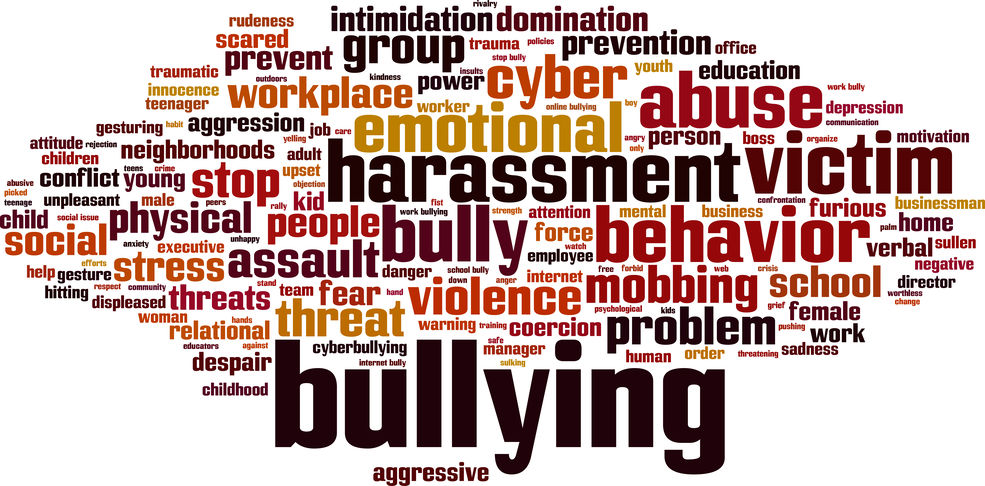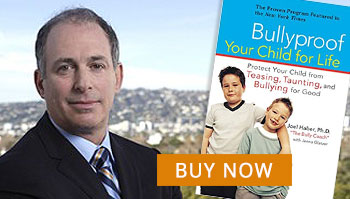
Copyright: Borislav Marinic / 123RF Stock Photo
There are three main types of bullying with different probable effects.
Physical Bullying
This is the one that’s easiest to identify. Punching, kicking, hair-pulling, bra-snapping, tripping, shoving someone into a locker— these can all be physical bullying episodes. Maybe surprisingly, this is usually the type of bullying with the fewest long-term scars for the target. Physical bullying has a beginning and an end. Once the incident is over, the bullying is over for a period of time. Depending on who wins the battle, the dynamic can shift immediately—the target can knock out the bully and suddenly gain power and brush off his target status. That’s not exactly the ideal; most likely, the bully will just move on to someone else, and the target will either learn that fighting back is a way to gain power or feel sick about the event. But it does sometimes stop the bullying.
Mark was a boy with a Catholic mother and a Jewish father, going to a Catholic prep school when he found a Swastika taped to his locker. He’d been called “Jew boy” before and had been taunted about his religion, as well as his size (short and skinny). He usually just ignored the taunts, and today was no exception. He stuffed the Swastika picture into his coat pocket and forgot about it until his father found it later that night and demanded to know what happened.
The school took the bullying seriously—so seriously that the bully was suspended from school, even though it seemed that no one was happy about that idea. The boy was very popular, and once word got out that it was Mark’s “fault” that the boy was kicked out, the bullying kicked into high gear.
He was in the locker room one day when a big athlete began chasing him around the room, threatening to kill him. Mark ran like his feet were on fire.
“Then I saw a half-open locker door in front of me,” he says. “As I ran past it, I swung it hard behind me, and the kid fell to the ground. I just thought, ‘Thank God,’ because if not for that locker, that kid was going to kill me!”
And the bullying stopped.
But Mark reflects that he knew even then that this was a pretty screwy way to solve the problem. There’s a danger in retaliation against a physical bully, of course. What if—and this is usually the case—the target can’t beat the bully? If the target takes the bully up on his challenge, there’s no guarantee whatsoever that the worst that’s going to happen is a black eye or a few bruises.
We have to remember that a large number of school kids today may have greater access to and awareness of weapons, and may, in fact, be carrying them. And what looks like a one-on-one challenge can turn into a ten-on-one fight.
But in typical cases, physical wounds heal. It’s when the physical bullying escalates or is combined with the other two forms of bullying that there’s more risk of long-term damage.
Verbal Bullying
Taunting and name-calling fit into this category. Boys and girls are about equally likely to verbally bully and be bullied. Boys may bully boys or girls; girls typically bully only other girls.
What starts out as a taunt based on truth can easily morph into taunting based on whatever seems to get a rise from the target, regardless of whether or not there’s any basis in reality. Maybe your child wears braces and kids call her “Metal Mouth.” They see they get a reaction from her, so they see what else they can call her to drive her up a wall. Doesn’t matter if she’s pretty and they call her “Horse-Face,” or if she’s an A student and they call her stupid; they’re not necessarily saying things they actually believe. They’re just saying things that trigger strong emotional and behavioral responses. If they see that she gets really upset when they say she stuffs her bra, it makes no difference if they actually think so or not—they’ll keep saying it because they see it upsets her.
They may find it even more fun to say ridiculous things they know aren’t true, because it shows they can get a rise for no reason at all. No one actually believes the bully when he says, “I slept with your mom last night,” or “You got those shoes out of the Dumpster,” but his cronies will still crack up if it elicits a denial from the target.
And the target may tell the parent, “I just ignored him! I didn’t do anything to provoke him and he still kept it up!” But what this usually means is, “I didn’t say anything and I didn’t cry.” There are plenty of other ways the child may have reacted without even realizing it was a reaction—body language and facial expressions can be dead giveaways that a kid has been affected, and enough proof for the bully that the bullying was successful.
The target may have frowned or closed her eyes, folded her arms, bitten her lip, furrowed her eyebrows, run away, put her head down, looked away in an exaggerated manner, or any number of other cues that signify hurt or anger. Seeing the target really go berserk is the ultimate goal, but these little visual cues are enough to keep up the behavior to see if the target will eventually crack completely.
By now, most of us realize that the adage “Sticks and stones may break my bones, but words will never harm me” is a load of bull. The truth is that broken bones heal. Broken hearts are much harder to mend, and broken spirits can be lifetime handicaps.
And parents, no matter how many times you tell your kids, “You’re smart and attractive,” if all they hear from peers is “You’re stupid and ugly,” the latter is what they’ll internalize. They don’t believe you. You’re biased—and besides, you’re “old”! You’re not going to negate the effects of verbal bullying just by assuring your child that the kids’ words aren’t true. Something has to change within the child to make the message sink in: Who cares what bullies think? I’m okay. I’m special. And who I am is perfectly likable.
Relational Bullying
Most popular among girls but also rampant among boys, the goal of this sort of bullying is social exclusion. It can take the form of gossip and exclusion from a lunch table, team, club, etc. If done on an ongoing basis, this form of bullying is likely the most hurtful and most damaging long-term. The targets don’t just feel bullied by one person; they feel bullied by the whole peer group. It’s a very sophisticated and manipulative form of bullying. It is also hitting a girl exactly where she’s vulnerable—in her social likability.
Beyond about grade four, children’s identity and self-esteem are dependent upon their peer groups far more than their families. When they feel shunned by and cut off from their peers, their self-esteem plummets and they feel like they have no “safe place.” It’s the exact opposite of what they want at that age, which is a feeling of belonging. Gossip, whether true or not, tend to be extremely hurtful and runs rampant in the young teen population.
Former friends may stop making eye contact and be passing the target in hallways out of fear of being associated with this “social pariah.” The target may hear giggling as she passes by, or watch people move away from her when she sits on a bench or on the school bus. Her trust in her peers is shattered, and she’s likely to feel helpless and very alone.
It mimics the way a child feels when punished by being put in a “time out” corner. No words are necessary; the child is made to feel bad by being excluded from the family or group activities.
This is also what’s at play when someone has a birthday party and invites everyone in the class . . . except for one or two kids. That’s just plain mean, and I encourage you as parents to make sure that your child doesn’t contribute to making someone else feel excluded. The rule I find appropriate is half or all, nothing in between. The child can invite everyone in the class, or half the people in the class (or less), but not a number in between those two.
As a parent, you may say this is ridiculous. “Why should I invite a kid who may be mean to my kid?” However, following along with the exclusion mind-set just teaches your child to do the same. They think, “Exclusion is acceptable if my parent allows it.”
“I remember feeling like such a loser when everyone in my sixth-grade class got invitations to a girl’s party, except for me and one other girl,” says a woman named Arisa. “I was a new girl in school, but it was a few months into the year, so she did know me. I spent the day looking around the room and thinking, “She thinks every person in this room is cooler than I am.” Apparently, she kissed a boy for the first time there, so the party was a hot topic for months afterward. I felt so isolated. And it was a self-fulfilling prophecy: the more insecure I felt about not being part of ‘the group,’ the less able I felt to make friends, which meant I just got more and more lonely and an easier target for teasing,”
